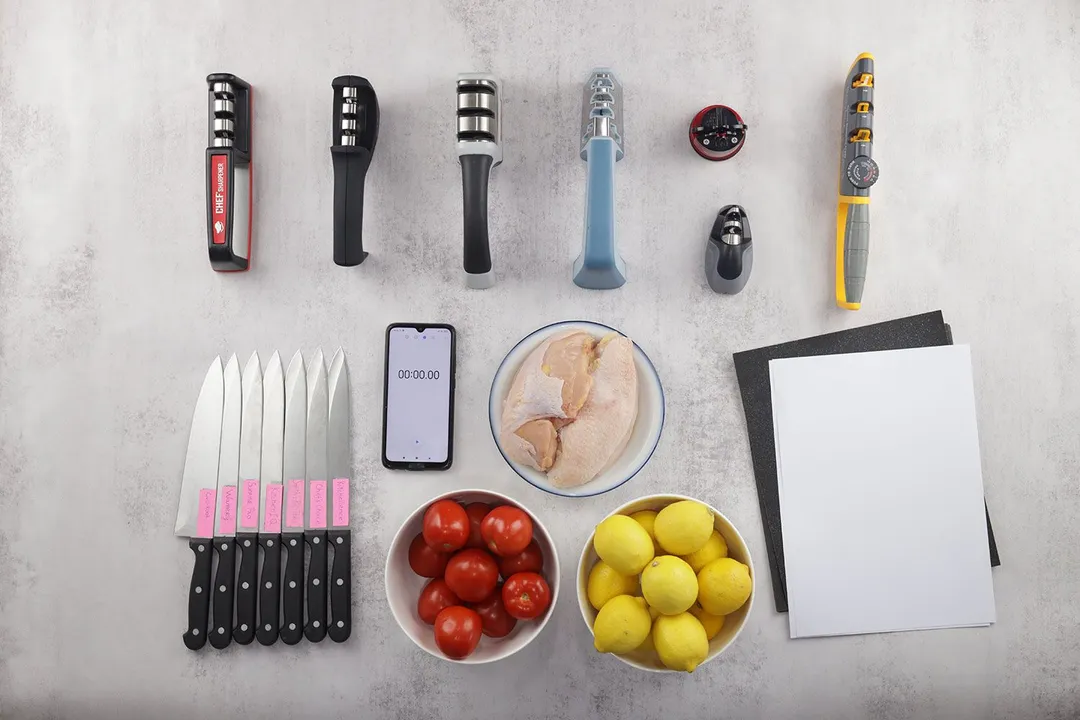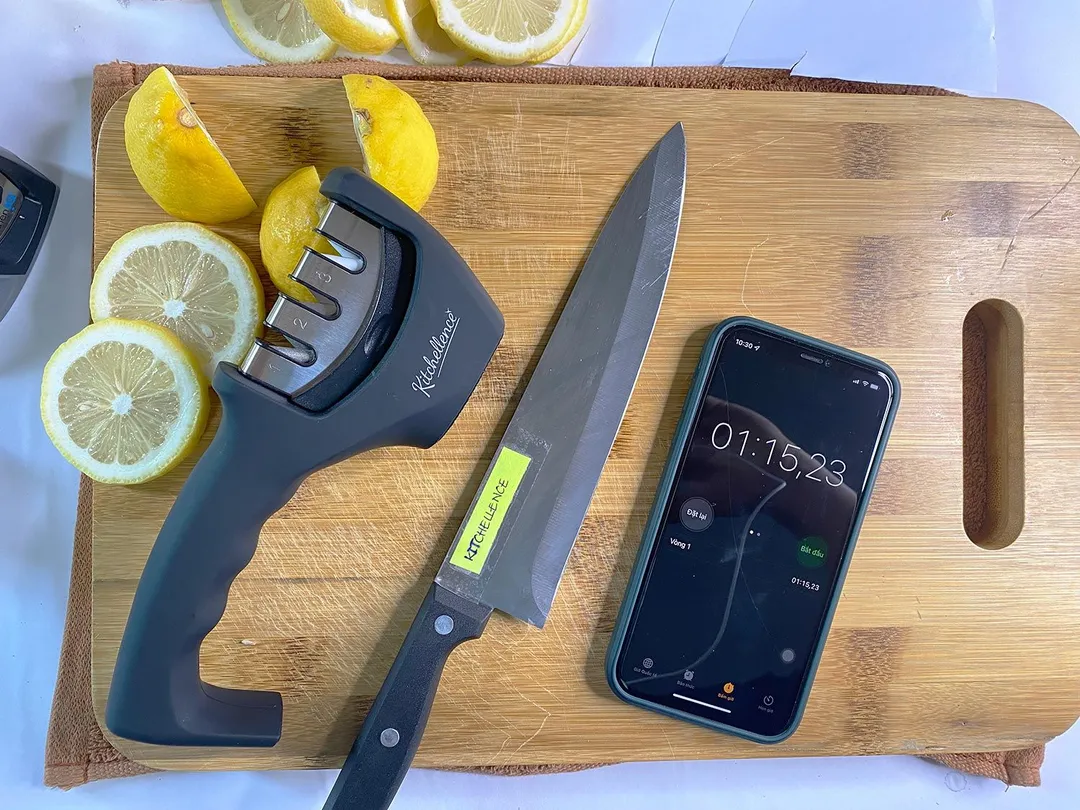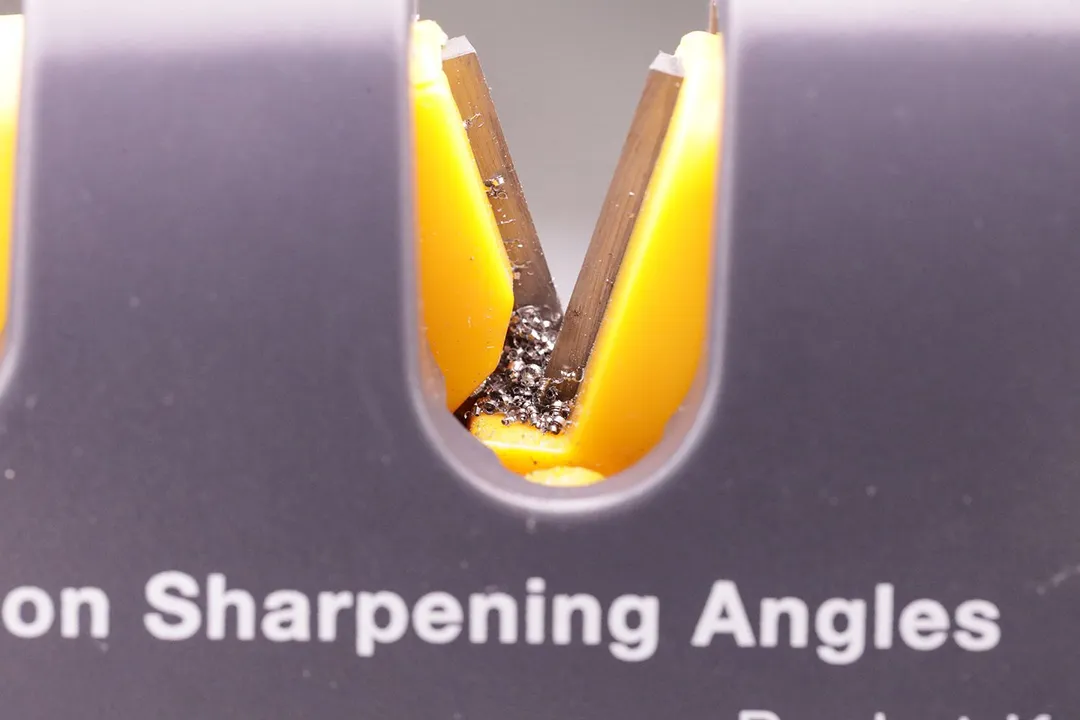How We Test Manual Knife Sharpenersv1.0
Manual knife sharpeners come in many different shapes and sizes, and a subtle change in the design can sometimes make a big difference in the results. But it can be challenging to pick one if you’ve never tried them before.
That’s why we bought a bunch of the most popular sharpening devices on Amazon and tested them out. We compiled a list of the most important criteria when choosing a sharpener — which varies depending on the type — and then conducted tests on all the different sharpening devices using those criteria.
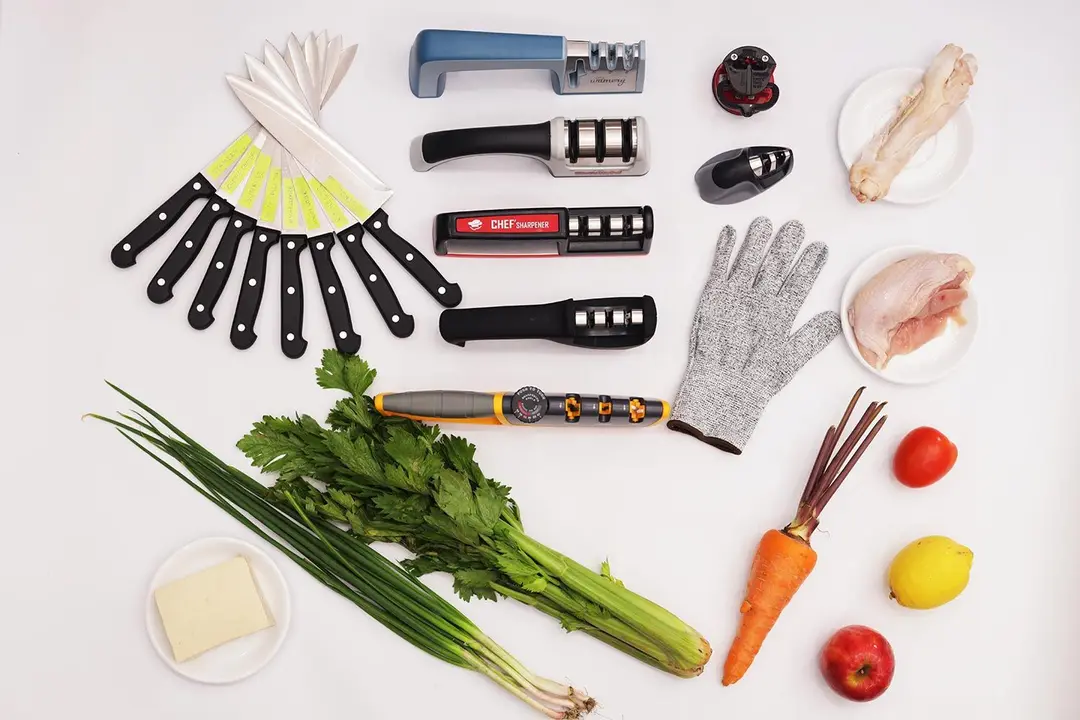
Criteria and Weighting
We allocated 50% of the total score to Performance, 35% to Ease of Use, and 25% to Design.
Performance
This is our assessment of how sharp you can make a knife with the device, the time it takes to sharpen, and what the edge looks like after sharpening.

Performance is the most important factor when choosing a manual sharpener. As such, 50% of the total score is allocated to this.
Here’s the list of our Performance tests and score tabulation. Click on to read in detail how the tests were performed and the results.
- Time to Reach Workable Sharpness: 35%
- Maximum Sharpness Achieved: 20%
- Edge Smoothness: 20%
- Material Retention: 25%
Ease of Use
These points reflect whether the device is intuitive, and if it’s stable when you use it. Ease of use takes up 35% of the total score for each device.
Below are the criteria we used to evaluate the ease of use and their respective score weights.
- Slot arrangement: 10%
- Insertion: 20%
- Pulling through: 10%
- Stability on a clean surface: 40%
- Stability on a wet and dirty surface: 20%

Slot Arrangement
The working section’s layout can have a great impact on a device’s ease of use.
Some devices have an intuitive arrangement with the slots placed in a progressive order. Usually, those sharpeners are made for a fixed angle and only sharpen one type of knife. Devices that allow for more angles, edge types (straight/serrated), and knife materials (metal/ceramic) are less likely to feature that simple progression. Even then, however, there are ways to design the sharpener to be relatively intuitive.
We assessed the slot arrangement after repeatedly using the sharpener. A deciding factor was whether it was possible to place the knife into the slot in one go rather than multiple attempts.
The user may have some initial difficulty on devices with odd slot arrangements, but will get used to them over time. This thus takes up 10% of the total score for Ease of Use.
Scoring
The device is rated from 1 to 10, with 10 indicating that the sharpening slots are arranged in a natural, progressive order that’s easy to detect and remember.
Insertion
Sharpening with a manual pull-through device involves repeatedly inserting your knife into a sharpening slot. A well-designed slot with reasonable width and depth makes the insertion easy, saving you frustration and also preventing you from further damaging your blade.
Easy insertion improves safety, too. It minimizes the risk of the blade sliding off the unit’s surface and cutting your hand.
Given its importance, insertion constitutes 20% of the total Ease of Use score.
Scoring
The device is rated from 1 to 10, with 10 indicating that insertion is natural, effortless, and unobstructed.
Pulling Through
In the knife-sharpening process, every pull counts. Every cook may have a different experience, even on the same device, but in general, we think that each draw should be effortless, comfortable, and safe.
The ease of pulling through does affect the overall experience. That being said, what’s more important in the end is whether it produces the smooth edge you want. Because edge smoothness is already covered in a different section, we allot only 10% of the overall Ease of Use score for this.
Score Checklist
The list below shows the maximum score achievable in each subcriteria. The maximum total score for all three subcriteria is 10 points and the minimum score is 0, with 0.5-point increments.
- Sharpening rods feel tight and secure: 3.5 points
- The pulling is smooth and without friction: 3.5 points
- The knife tip does not cut into the holder at the end: 3 points
Device’s Stability When Working on a Clean Surface
This test aims to determine if a sharpening device is secure and steady in a normal working environment.
Most people sharpen or hone their knives before cooking, when their kitchen countertop is still dry and clean. For this reason, we allocate 40% of the total Ease of Use score to this test.
For this test, we placed the sharpening device on the countertop and sharpened a chef’s knife with it. We then observed if we had to use a lot of force to keep the device in place, and if it wobbled or slipped from the countertop.
Scoring
The device is rated based on a 0 to 10 scale at 1-point increments. A score of 10 indicates that the device stays securely in place when only hand weight is applied, while a score of 0 means the device can’t stand on its own even when not in operation.
Device’s Stability When Working on a Wet and Dirty Surface
Sometimes you need to hone your knife halfway through a cooking session. It’s rare that the countertop surface is in top-notch condition during this time — there’s usually spices, water, and other liquids or food materials on it. We recreated a dirty countertop and tested to see if the sharpener still maintained its stability in this environment.
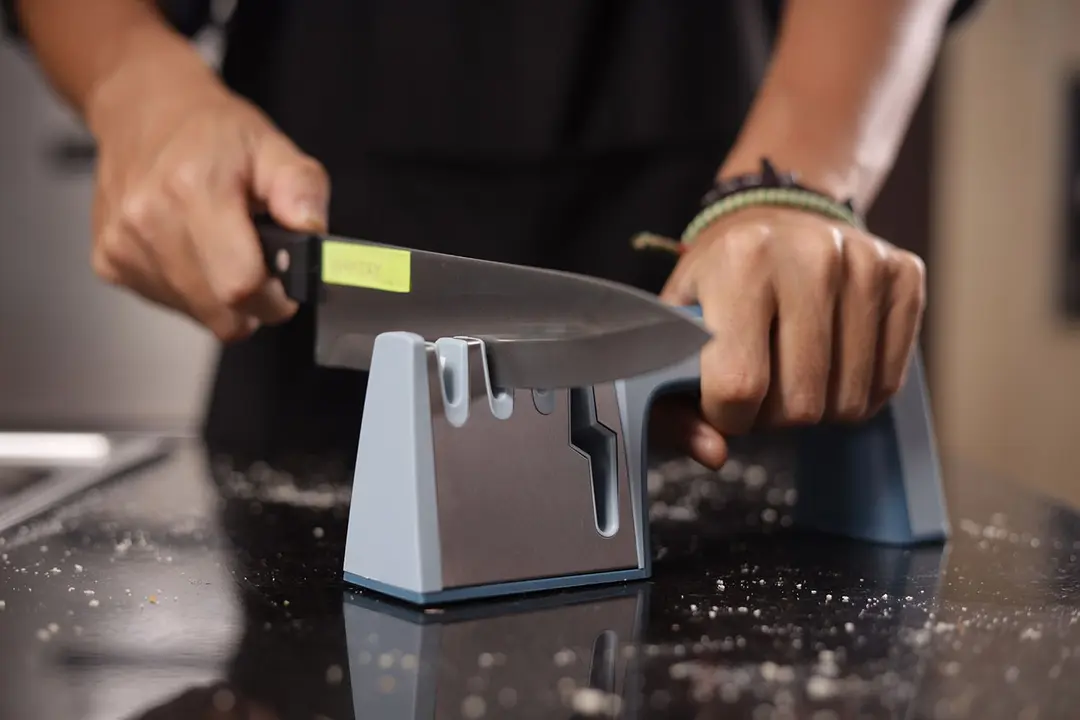
Because most sharpening happens before, not during cooking, this test is allocated 30% of the total stability score.
For the test, we spread 1 teaspoon of cooking oil onto the countertop and sprinkled 1 teaspoon of pepper and 1 teaspoon of salt on top of it. We sharpened a chef’s knife on this surface and observed the force used to keep the device in place, and if it wobbled or slipped off from its position.
Scoring
The device is rated using the same scoring system as in Test 1.
Design
As Steve Job had it, “It's not just what it looks like and feels like. Design is how it works.” A good design offers safety and comfort, and an attractive one makes you want to use the sharpener more often.
The design enjoys a score weight of 15%. This score is based on the overall build quality and the grip.
Grip
A firm grip gives you more confidence when sharpening your knives. Handles with ergonomic designs and skin-friendly materials keep you comfortable if you have to use the device for more than a few minutes. A handle that’s placed closer to the base also helps with safety — it keeps the device stable during operation.
Traits that contribute to a good grip include its size, shape, center of gravity, and external material. Of course, grip is subjective to some extent — people with larger hands may prefer a bulky handle, whereas those with short fingers will find smaller ones more comfortable to hold. As such, the actual feel as you hold it should also be taken into account.
Grip constitutes 25% of the total Design score.
While a ‘good grip’ is not entirely objective, our team unanimously decided that the size, shape, center of gravity, and material can predict which are better to hold. We also rated the overall experience of holding the grip.
Score Checklist
The list below shows the maximum score achievable in each subcriteria. The maximum total score is 10, while the minimum score is 0, with 0.5-point increments.
- The handle has a decent size: 2 points
- The handle has an ergonomic shape: 2 points
- The exterior material is soft to the touch while offering good friction: 1.5 points
- The handle is placed close to the base: 2 points
- The grip feels secure, easy, and comfortable: 2.5 points
Build Quality
Build quality refers to the general quality of both the construction and materials.
Build quality has a significant influence on your overall sharpening experience. A well-built device offers better safety, comfort, and stability. It affects the results of the sharpening session, too — it’s easier to get a sharp, smooth edge out of a sturdy device compared to a shoddy one.
Sharpeners that are better-built can survive more abuse, misuse, and accidents. They not only have longer lifespans but also stay more useful throughout that time.
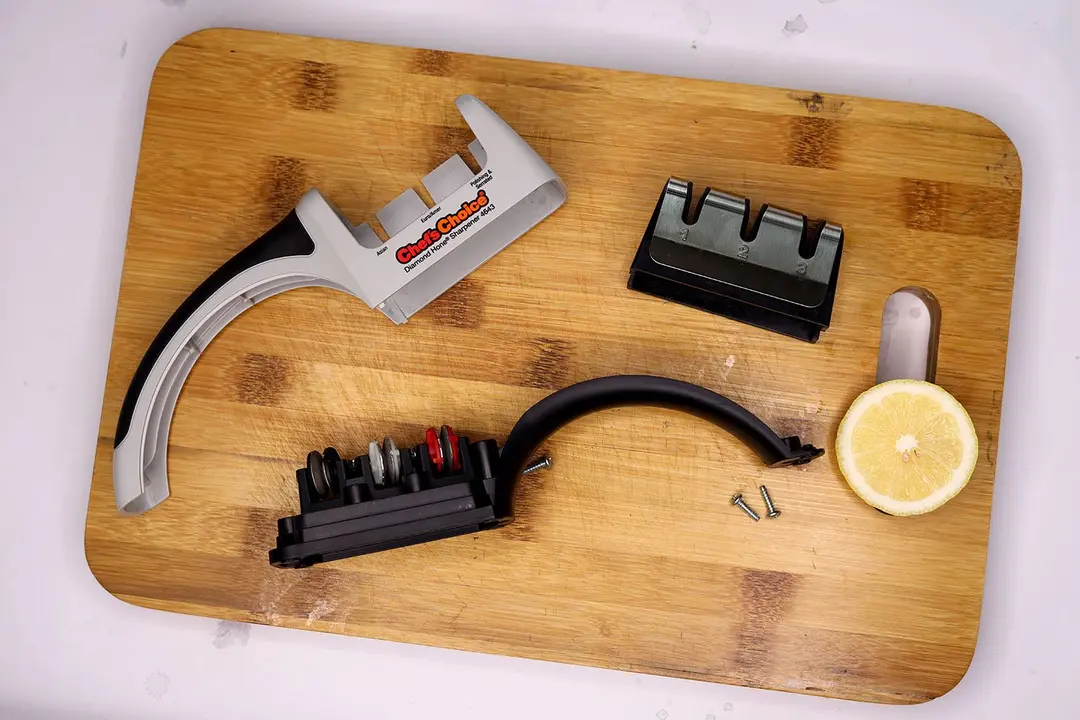
Build quality constitutes 75% of the total Design score.
We evaluated the build quality of each sharpening device based on three factors: the overall construction of the device, the quality of the materials used to make it, how well the parts fit together and whether the finish is flush and comfortable to the touch.
We inspected the device from all angles, checking the parts, shaking the device and trying to detach them by force. We then sharpened a knife with it to check if its parts stay together tightly or if they wobble, shake, or pull away from each other during sharpening.
Scoring
- Sturdiness (Score weight: 40%)
Device is rated from 1 to 10. A score of 1 shows that the device feels shoddy. 10 means the device is sturdy, solid, and well-built.
- Material Quality (Score weight: 40%)
Device is rated from 1 to 10. A score of 1 indicates that the device feels cheap and flimsy. 10 means the device is made of quality materials.
- Fit & Finish (Score weight: 20%)
Device is rated from 1 to 10. A score of 1 is given when parts fit loosely, causing the device to rattle when shaken or sharpening. 10 is given when the parts fit together tightly and uniformly.



